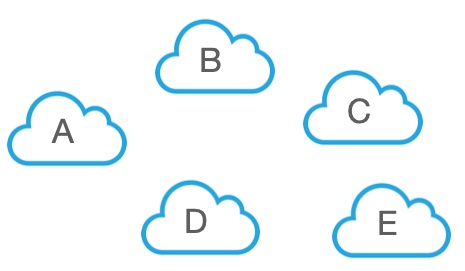Future is Multi-cloud

Many companies are on a public cloud journey and they have gained a lot of experiences of the cloud development. In a typical scenario the work started with one cloud. All skills and resources were focused on the cloud ramp-up, and the cloud structures and governances were founded. In the beginning it was maybe thought that when one cloud is well and properly established, it is enough for the company purposes in a long term. It is also very common that within the company there are units or a group of people who favor some other cloud that is not in the main stream. The usage of several clouds with unclear roles causes confusion. From the management perspective this is a nightmare; for example the cloud governance, security and integrations from and to the cloud should all be carefully established in all clouds.
How should the company choose the “right” cloud for its use?
When pondering the answer to this question, it is good the revise why the clouds are used in the first place. Common reasonings are cost savings, global reachability, flexibility, faster and more reliable product development, usage of the best of breed services, etc. Nowadays most of the clouds are mature and easy to use. When selecting a Software as a Service (SaaS) cloud, the required skills and development efforts are smaller. The currently available public clouds are very similar but they have also some different characteristics, and in large organizations these may be significant. It is almost inevitable that after some years in the cloud journey, the company end ups to the Multi-cloud setup. It is better to be prepared than to resist, and when doing so one may affect the future in a more predictable way.
Fully new aspects come when the usage of the Industrial Internet of Things (IIoT), Machine Learning (ML) and 5G become more prevalent in the businesses. Sensors produce data and ML models consume data. The amount of data produced and used increase exponentially. There is no such a bandwidth available that can transfer the data with a minimum latency to central processing. The data needs to be processed close to the location where it is produced. For example, in a Factory IoT use case, it doesn’t make sense to transfer all the data outside of the factory, but only the key indicators after the ML models have made the needed inferences from the raw data. In this use case there is a need for a private cloud in the factory with very similar cloud services that are available in the public cloud, for example, fast and scalable processing capacity, massive and cheap data storage, advanced machine learning tools, etc.
This leads to the situation that the Future will be Multi-cloud. Data drives the development. Instead of centralizing all the services one should consider architectures where data sources form domains. In addition to global clouds, there is a need for several local clouds that can be tailored. The selection of the cloud depends on the business requirements and the data. In the cloud market this will cause a new competition situation and challenges to the current global public cloud vendors. Only a very few vendors can provide a strong local presence.
Are you ready? The Multi-cloud is behind the door.
More topics on Blog and articles.